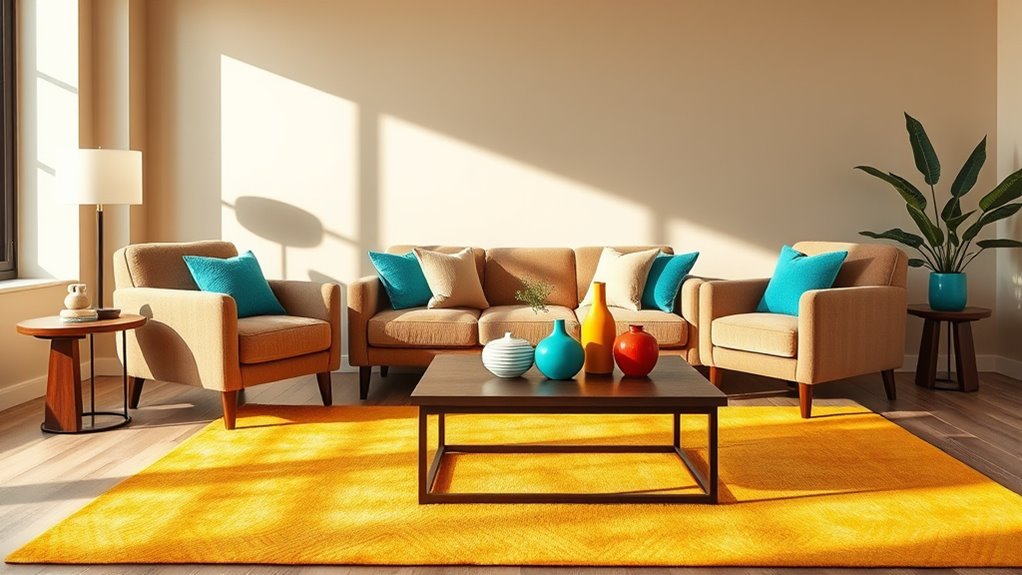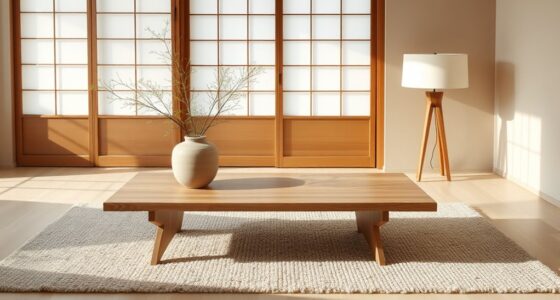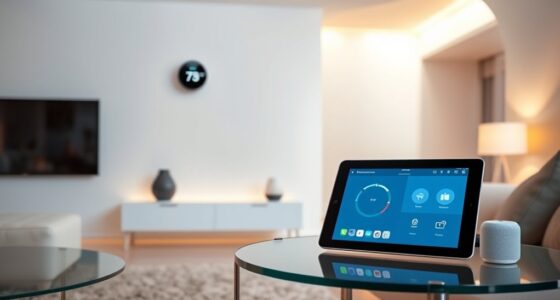To create harmonious home interiors, start by understanding complementary colors—pairs opposite on the color wheel like blue and orange—that add vibrancy or softness, depending on your use. Balance warm tones (reds, oranges) with cool tones (blues, greens) to evoke cozy or calming moods. Keep lighting in mind, as it affects color perception. Mastering these basics helps craft spaces that reflect your style and mood—keep exploring for more tips on mixing and balancing colors.
Key Takeaways
- Use complementary color schemes (opposite on the color wheel) for vibrant, high-contrast interiors.
- Balance warm (reds, oranges, yellows) and cool (blues, greens, purples) tones to create harmony.
- Incorporate muted or softer shades of complementary colors to promote visual harmony and avoid overwhelming spaces.
- Consider lighting conditions, as natural and artificial light influence how colors appear in rooms.
- Experiment with tone balance and contrast to reflect personal style and set the desired mood in each space.

Have you ever wondered how certain colors transform a room’s mood and vibe? It’s fascinating how choosing the right color scheme can completely alter your space’s atmosphere. One effective approach is understanding complementary schemes, which involve pairing colors opposite each other on the color wheel. These combinations create high contrast and vibrancy, making a room feel lively and energetic. For example, pairing blue with orange or red with green can produce striking visual interest, drawing the eye and adding depth. Complementary schemes work well when you want a bold, dynamic look, but they require balance. If one color dominates, the other should be used as an accent to prevent overwhelming the space. When working with complementary colors, consider their intensity and saturation; softer, muted versions can create a more harmonious environment, while vivid shades boost energy.
Another important aspect is grasping the distinction between warm and cool tones. Warm tones—think reds, oranges, and yellows—generate a cozy, inviting vibe. They tend to make a space feel more intimate and energetic, perfect for living rooms or kitchens where you want to foster warmth and social interaction. On the other hand, cool tones like blues, greens, and purples evoke calmness and serenity. These shades are ideal for bedrooms or bathrooms, where relaxation is key. When designing your space, mixing warm and cool tones intentionally can add contrast and interest, but be cautious not to clash. For example, pairing a soft blue wall with warm beige accents can create a balanced, soothing environment. Conversely, using too many warm or cool tones in one room can make it feel disjointed or overwhelming, so moderation is essential.
Understanding how to combine warm and cool colors, along with complementary schemes, gives you a powerful toolkit for expressing your style. If you want a lively, energetic room, choose warm tones and complement them with bright accents. If serenity is your goal, lean toward cool hues and balance them with neutral or soft warm shades. Don’t forget that lighting influences how these colors appear—what looks vibrant in daylight may seem different under artificial light. Additionally, incorporating color theory principles can help you select harmonious palettes that enhance your space’s mood and aesthetic. By experimenting with these concepts, you can craft spaces that reflect your personality and meet your mood needs. Ultimately, mastering complementary schemes and warm versus cool tones empowers you to create harmonious, inviting interiors that truly resonate with your vision.
Frequently Asked Questions
How Can I Incorporate Bold Colors Without Overwhelming My Space?
You can incorporate bold colors by using accent walls to add vibrancy without overwhelming your space. Choose one wall to feature a bold hue, and keep surrounding areas neutral. Add color accents through accessories like pillows, artwork, or rugs to tie the look together. This approach balances energy and calm, allowing bold colors to stand out while maintaining harmony in your home.
What Are the Best Color Combinations for Small Rooms?
You should choose light, neutral colors for small rooms and add pops of color through accessories. Use the color wheel to find complementary schemes—pairing shades opposite each other, like blue and orange, creates visual interest without overwhelming the space. Keep walls and larger furniture subdued, then incorporate bold accents for contrast. This approach makes your small room feel vibrant yet balanced and spacious.
How Do I Match Wall Colors With Existing Furniture?
To match wall colors with existing furniture, start by identifying the furniture’s dominant tones. Use complementary palettes to create contrast or neutral balancing for a seamless look. If your furniture features bold colors, opt for softer wall shades like beige or light gray to tone it down. Conversely, for neutral furniture, add a pop of color with accent walls or accessories, ensuring the overall harmony of your space.
Can Color Psychology Influence Mood in Home Interiors?
Yes, color psychology can influence your mood in home interiors by triggering emotional responses and tapping into cultural associations. For example, blue often promotes calmness, while red energizes. Your personal experiences and cultural background shape how you interpret these colors, making your environment feel more restful or stimulating. By choosing colors thoughtfully, you can create spaces that support your desired emotional state and enhance your overall well-being.
What Trends Should I Consider When Choosing Interior Colors?
Did you know that 65% of homeowners prioritize trending shades when choosing interior colors? When selecting a color palette, consider current trends like warm neutrals, muted greens, and bold accent colors. These trending shades can refresh your space and boost your mood. Stay updated with design magazines or social media to find inspiration, and don’t be afraid to mix modern hues with classic styles for a personalized touch.
Conclusion
Remember, colors speak louder than words in your home. By understanding color theory, you can create a space that truly reflects your personality and mood. Don’t be afraid to experiment, trust your instincts, and make thoughtful choices. As the saying goes, “A picture is worth a thousand words.” Use color to tell your story and transform your house into a warm, inviting home you’ll love to live in.









